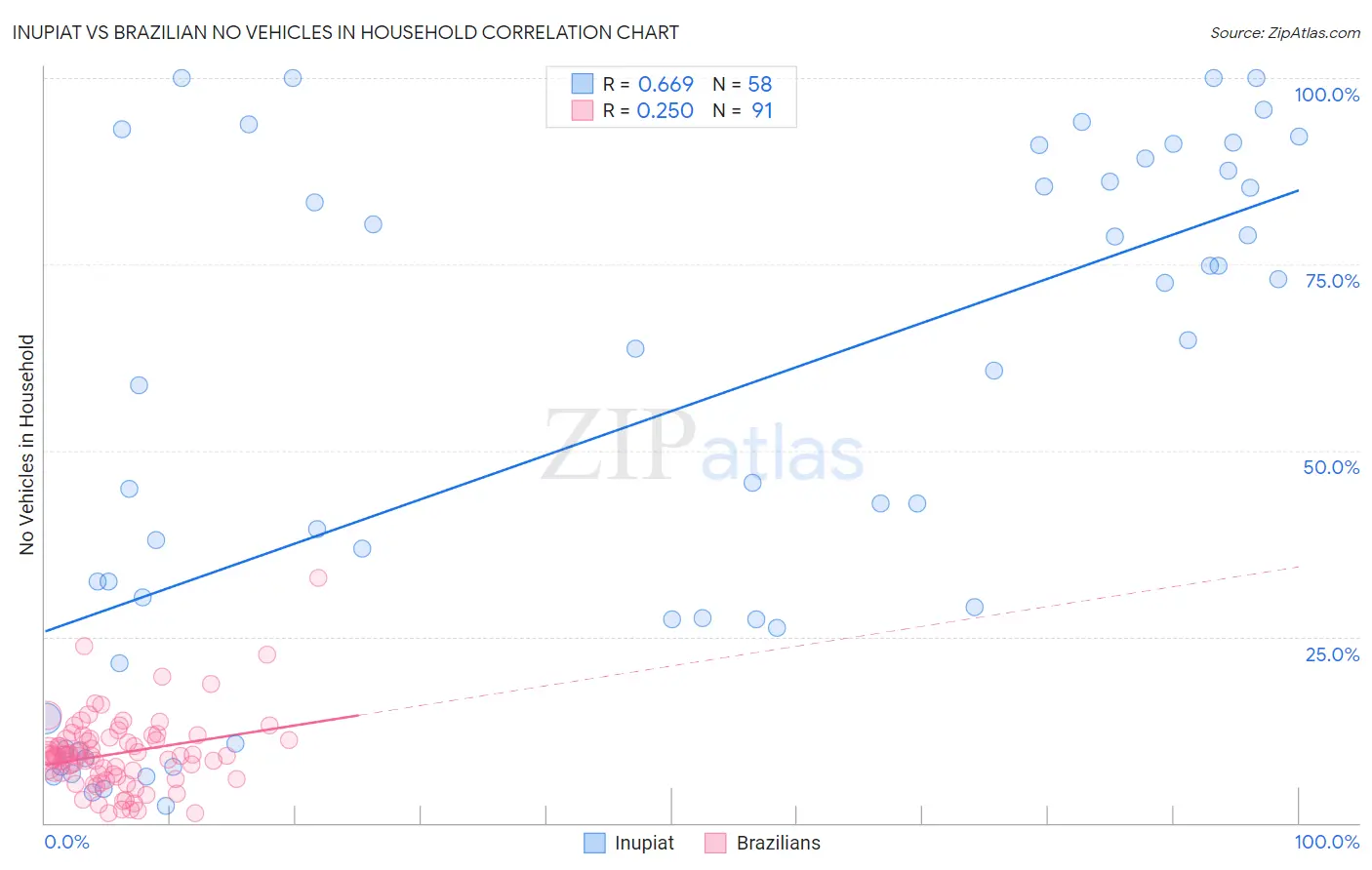Inupiat vs Brazilian No Vehicles in Household
COMPARE
Inupiat
Brazilian
No Vehicles in Household
No Vehicles in Household Comparison
Inupiat
Brazilians
29.9%
NO VEHICLES IN HOUSEHOLD
0.0/ 100
METRIC RATING
343rd/ 347
METRIC RANK
10.4%
NO VEHICLES IN HOUSEHOLD
51.7/ 100
METRIC RATING
172nd/ 347
METRIC RANK
Inupiat vs Brazilian No Vehicles in Household Correlation Chart
The statistical analysis conducted on geographies consisting of 96,243,666 people shows a significant positive correlation between the proportion of Inupiat and percentage of households with no vehicle available in the United States with a correlation coefficient (R) of 0.669 and weighted average of 29.9%. Similarly, the statistical analysis conducted on geographies consisting of 322,964,874 people shows a weak positive correlation between the proportion of Brazilians and percentage of households with no vehicle available in the United States with a correlation coefficient (R) of 0.250 and weighted average of 10.4%, a difference of 187.7%.

No Vehicles in Household Correlation Summary
| Measurement | Inupiat | Brazilian |
| Minimum | 2.2% | 1.2% |
| Maximum | 100.0% | 32.9% |
| Range | 97.8% | 31.6% |
| Mean | 53.1% | 9.3% |
| Median | 52.3% | 9.0% |
| Interquartile 25% (IQ1) | 26.2% | 6.6% |
| Interquartile 75% (IQ3) | 86.0% | 11.4% |
| Interquartile Range (IQR) | 59.9% | 4.8% |
| Standard Deviation (Sample) | 34.0% | 5.0% |
| Standard Deviation (Population) | 33.7% | 5.0% |
Similar Demographics by No Vehicles in Household
Demographics Similar to Inupiat by No Vehicles in Household
In terms of no vehicles in household, the demographic groups most similar to Inupiat are British West Indian (29.7%, a difference of 0.41%), Immigrants from Guyana (29.5%, a difference of 1.3%), Immigrants from Barbados (29.5%, a difference of 1.3%), Dominican (29.4%, a difference of 1.5%), and Guyanese (29.3%, a difference of 1.9%).
| Demographics | Rating | Rank | No Vehicles in Household |
| Immigrants | Trinidad and Tobago | 0.0 /100 | #333 | Tragic 24.6% |
| Immigrants | Bangladesh | 0.0 /100 | #334 | Tragic 25.8% |
| Barbadians | 0.0 /100 | #335 | Tragic 26.1% |
| Vietnamese | 0.0 /100 | #336 | Tragic 26.2% |
| Immigrants | Uzbekistan | 0.0 /100 | #337 | Tragic 26.7% |
| Guyanese | 0.0 /100 | #338 | Tragic 29.3% |
| Dominicans | 0.0 /100 | #339 | Tragic 29.4% |
| Immigrants | Barbados | 0.0 /100 | #340 | Tragic 29.5% |
| Immigrants | Guyana | 0.0 /100 | #341 | Tragic 29.5% |
| British West Indians | 0.0 /100 | #342 | Tragic 29.7% |
| Inupiat | 0.0 /100 | #343 | Tragic 29.9% |
| Immigrants | Dominican Republic | 0.0 /100 | #344 | Tragic 31.4% |
| Immigrants | St. Vincent and the Grenadines | 0.0 /100 | #345 | Tragic 35.4% |
| Immigrants | Grenada | 0.0 /100 | #346 | Tragic 37.5% |
| Yup'ik | 0.0 /100 | #347 | Tragic 45.9% |
Demographics Similar to Brazilians by No Vehicles in Household
In terms of no vehicles in household, the demographic groups most similar to Brazilians are Hmong (10.4%, a difference of 0.14%), Immigrants from Latin America (10.4%, a difference of 0.21%), Filipino (10.4%, a difference of 0.22%), Immigrants from Sudan (10.4%, a difference of 0.23%), and Immigrants from Burma/Myanmar (10.4%, a difference of 0.34%).
| Demographics | Rating | Rank | No Vehicles in Household |
| Comanche | 60.8 /100 | #165 | Good 10.2% |
| Immigrants | Costa Rica | 60.5 /100 | #166 | Good 10.3% |
| Immigrants | Saudi Arabia | 58.8 /100 | #167 | Average 10.3% |
| Indonesians | 56.7 /100 | #168 | Average 10.3% |
| Lumbee | 54.7 /100 | #169 | Average 10.3% |
| Immigrants | Latin America | 53.2 /100 | #170 | Average 10.4% |
| Hmong | 52.7 /100 | #171 | Average 10.4% |
| Brazilians | 51.7 /100 | #172 | Average 10.4% |
| Filipinos | 50.1 /100 | #173 | Average 10.4% |
| Immigrants | Sudan | 50.0 /100 | #174 | Average 10.4% |
| Immigrants | Burma/Myanmar | 49.1 /100 | #175 | Average 10.4% |
| French American Indians | 49.1 /100 | #176 | Average 10.4% |
| Immigrants | El Salvador | 49.1 /100 | #177 | Average 10.4% |
| Immigrants | Ethiopia | 48.0 /100 | #178 | Average 10.4% |
| Ethiopians | 45.8 /100 | #179 | Average 10.5% |